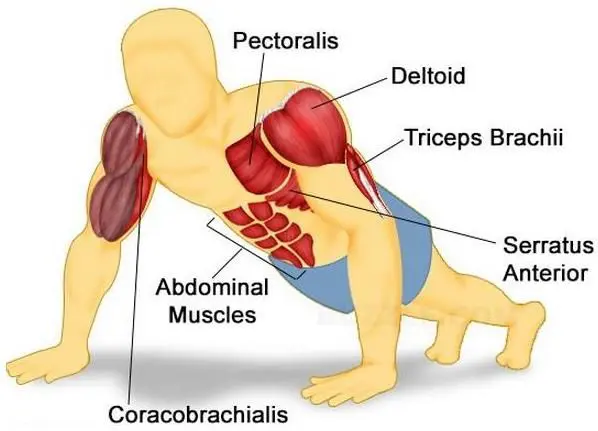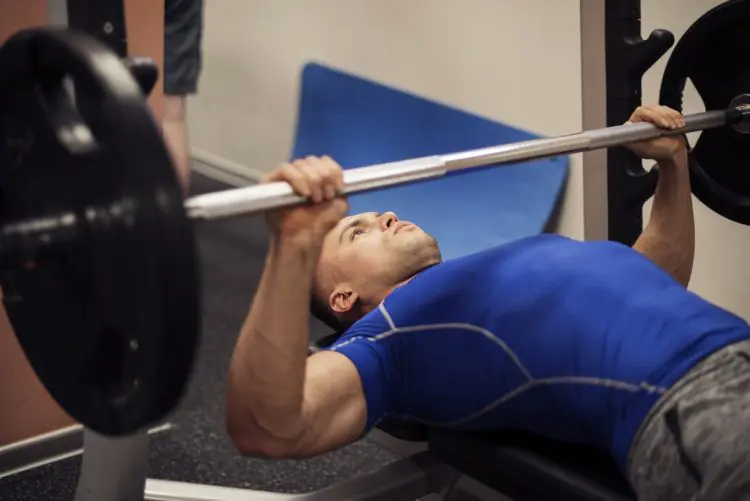Despite their obvious popularity, a lot of people’s push-up form leaves a lot to be desired. To do more reps, or simply because of a lack of strength, they don’t bend their arms enough, fail to keep their bodies straight, bounce off the floor, crane their heads downward, or commit other push-up “sins.”
Proper coaching can help prevent and correct many of these issues, and regressing to something like kneeling push-ups may be necessary too. There is also a push-up variation that is a lot more “cheat-proof” – hand-release push-ups.
In this article, we reveal how to do hand-release push-ups and explain their benefits, drawbacks, and alternatives.
What Are Hand Release Push-Ups?
Hand-release push-ups are so-called because, at the bottom of each rep, you lift your hands off the floor. Because you can only do this with your chest resting on the floor, hand-release push-ups force you to use a full range of motion, making push-ups much more cheat-proof.
As well as ensuring you use a full range of motion for every rep, hand-release push-ups increase upper back muscle activation, making them a more balanced exercise.
Finally, by lying flat between reps, each rep starts from a dead stop, which may increase muscle activation.
Level Up Your Fitness: Join our 💪 strong community in Fitness Volt Newsletter. Get daily inspiration, expert-backed workouts, nutrition tips, the latest in strength sports, and the support you need to reach your goals. Subscribe for free!
Hand Release Push-Up Anatomy

Hand release push-ups are a compound exercise. That means they involve multiple muscles and joints working together. The main muscles involved in hand-release push-ups are:
Pectoralis major – known as the pecs for short, these muscles are the prime movers in hand-release push-ups. If you want to build a stronger, bigger, or more toned chest using just your bodyweight, hand-release push-ups are an excellent choice.
Triceps – located on the back of your upper arm, the triceps play a synergistic or secondary role during push-ups. The triceps extend your elbows.
Deltoids – there are three deltoid muscles; anterior (front), posterior (rear), and medial (middle). Surrounding your shoulders, all three deltoids are involved in hand-release push-ups, but the anterior and posterior heads are the most active.
Middle trapezius and rhomboids – located across and between your shoulder blades, the mid traps and rhomboids are responsible for retracting your shoulder girdle. Lifting your hands off the floor increases the activation of these critical postural muscles.
Core – these muscles encircle your midsection to support and stabilize your spine. The anterior core prevents your hips from dropping out of alignment, whereas your posterior core is more active when you lift your hands off the floor.
How to Do Hand Release Push-Ups
There are two ways to do most exercises; the right way and the wrong way. The right way produces the greatest benefits with the lowest amount of risk. The wrong way could lead to injury.
Follow these step-by-step instructions to make sure you’re doing hand-release push-ups correctly.
1 – kneel down and place your hands flat on the floor, slightly wider than shoulder-width apart. Your fingers should be pointing directly forward. Walk your feet back, making sure your body is straight and rigid; brace your core. Look straight down at the floor.
2 – bend your arms and, under control, lower your chest to the floor. Keep your body tense and straight.
3 – pull your shoulders down and back and lift your hands a few inches off the floor. Imagine you are doing a bent-over barbell row. Do not arch your lower back.
4 – place your hands back on the floor and push yourself back up to return to the starting position. Extend your arms explosively to overcome inertia and increase muscle activation and power.
You can make this exercise easier by bending your legs and resting on your knees. Alternatively, make it more challenging by wearing a weighted vest. However, unlike regular push-ups, you CANNOT do this exercise with your feet elevated on a bench or step. While this would put more weight on your hands, it would mean hyperextending your lumbar spine, which could lead to back pain and injury.
Benefits of Hand Release Push-Up
Still not sure if hand-release push-ups deserve a place in your workouts? Consider the following benefits and advantages…
Less chance of cheating – with hand-release push-ups, you must lower your chest all the way to the floor. There is no such thing as a half-rep hand release push-up. This push-up variation keeps you honest!
Increased range of motion – lifting your hands off the floor increases the range of motion at your shoulders by roughly 10%. This may help increase shoulder joint mobility and pec and deltoid muscle flexibility.
Level Up Your Fitness: Join our 💪 strong community in Fitness Volt Newsletter. Get daily inspiration, expert-backed workouts, nutrition tips, the latest in strength sports, and the support you need to reach your goals. Subscribe for free!
Increased muscle activation – when you do regular push-ups, there is no pause between your descent and ascent. This means that at least some of the movement is powered by the elasticity of your muscles and tendons, which is something called the myotatic stretch reflex.
Lifting your hands off the floor forces you to pause briefly between reps, which means your muscles have to generate force from a dead stop, increasing muscle activation in the process.
Better posture – regular push-ups mainly work your pecs, deltoids, and triceps. If you want to work the opposing muscles (middle traps, rhomboids), you’ll need to do a rowing exercise.
Lifting your hands off the floor during hand-release push-ups provides your chest with a brief stretch and also works your upper back, making this variation better for your posture than regular push-ups.
Increased muscle power – starting each rep from a dead stop increases muscle power, which is your ability to generate force quickly. Powerlifters do paused bench presses and box squats for this precise reason.
Variety – hand-release push-ups are a useful way to add variety to your push-up workouts. If you’re getting bored of regular push-ups, this exercise could help make your workouts more interesting and productive.
The Drawbacks of Hand Release Push-Ups
As useful as hand-release push-ups can be, they are not without drawbacks. Consider the following before adding this exercise to your workouts…
Increased lower back strain – when doing hand-release push-ups, you should pull your shoulders back and lift your hands without extending your lumbar spine. However, this is easier said than done. Some exercisers may experience increased lower back stress if they also lift their chest off the floor.
Require good shoulder mobility – if you have tight shoulders, you may find lifting your hands off the floor impossible. Or, to lift your hands, you could end up arching your lower back instead. This is not a good exercise for people with immobile shoulders or tight pecs or anyone with existing shoulder pain.
Uncomfortable – laying flat on your stomach may not be comfortable for some exercisers, especially if you are very overweight. This exercise is also unsafe during pregnancy.
Hand Release Push-Up Alternatives
Not convinced that hand-release push-ups are the right exercise for you? Try these alternatives:
Renegade row/push-up complex

Renegade rows are an excellent upper back, core, and biceps exercise. However, you can also combine them with push-ups to create a move that rivals hand-release push-ups.
How to do it:
- With a dumbbell in each hand, squat down and adopt the push-up position. Your arms should be straight, and the weights should be roughly shoulder-width apart. Brace your core.
- Bend your arms and lower your chest to within an inch or two of the floor. Push yourself back up.
- Keeping your core tight and your shoulders and hips level, row one dumbbell into your ribs and then put it back down on the floor. Then, row the other dumbbell in and put it back down.
- Do another push-up.
- Continue this sequence of moves for as many reps as necessary. Keep your core tight throughout.
Paused bench press

Like hand-release push-ups, paused bench presses help increase muscle power. This is a popular powerlifting accessory exercise. Go a little lighter than usual; the pause makes this exercise much harder than regular bench presses.
How to do it:
- Lie on the bench with your eyes directly under the bar. Reach up and hold it using an overhand, slightly wider than shoulder-width grip. Pull your shoulders down and back, and push your upper back firmly into the bench. Brace your abs and drive your feet into the floor to stabilize your lower back.
- Unrack the bar and hold it over your chest.
- Bend your arms and lower the bar smoothly to lightly touch your chest.
- Without relaxing, pause with the bar touching your chest for 2-3 seconds.
- Drive the bar up and return to the starting position, and repeat.
Push-up/band pull-apart superset

While hand-release push-ups involve more upper back work than regular push-ups, the mid traps and rhomboids aren’t really worked all that hard. Most lifters would benefit from doing a more targeted back exercise. This superset pairs push-ups with band pull-aparts to deliver a balanced upper-body workout.
How to do it:
- Do your push-ups as normal, repping out to failure or until you have done the number of prescribed reps.
- On completion, hold and raise a resistance band to shoulder height, with your hands facing the floor. Pull your shoulders down and back.
- Open your arms and stretch the band out across your chest.
- Bring your hands back in and repeat.
- Do not relax between reps; keep some tension on the band at all times.
Hand-Release Push-Up – Wrapping Up
There are dozens of different push-up variations you can use to keep your workouts fresh and interesting. Variety is important because if you keep doing the same exercises over and over, your body will eventually adapt, and your gains will slow and may even stall.
Hand release push-ups are a useful alternative to regular push-ups. As well as being good for your pecs and triceps, this exercise increases mid-trap, rhomboid, and posterior deltoid recruitment, making them a more balanced upper body exercise.
Also, doing hand-release push-ups keep you honest; you can’t just bend your arms a few inches and call it a rep. Your chest MUST rest on the floor; otherwise, you won’t be able to lift your hands.
Are hand release push-up better than regular push-ups? Probably not. However, they’re definitely as effective and could be a worthy addition to your push-up arsenal.
Interested in measuring your progress? Check out our strength standards for Bench Press, Push Ups, Box Squat, and more.








